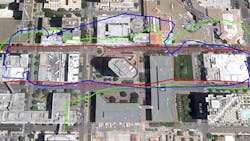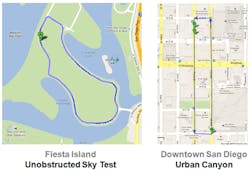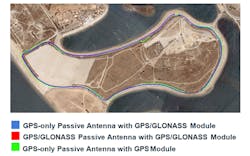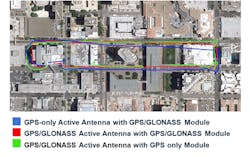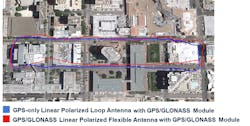Real-World Drive Tests Declare A Verdict On GPS/GLONASS
Download this article in .PDF format
In the United States, the Global Positioning System (GPS)—a global satellite navigation system—is synonymous with position and location awareness, and has become an essential tool in business and consumer applications. However, the U.S.-run GPS system isn’t the only cloud in the navigational sky. Companies that design tracking products, telematics, and other GPS-enabled M2M devices need to be aware of the Russian government’s Global Navigation Satellite System (GLONASS). Why does GLONASS matter and what does it offer?
The orbits of GLONASS satellites suit this system for high latitudes (north or south), where obtaining a GPS signal can be problematic. That’s not to suggest GLONASS should replace GPS, though. Instead, wireless device designers would be wise to consider using receivers and antennas that acquire and process signals from both GPS and GLONASS constellations. The theoretical benefit is much faster performance with greater and more stable accuracy.
To determine the sensitivity of GPS and GLONASS, researchers at Taoglas (www.taoglas.com), conducted a test in October 2012 with various single- (GPS only) and dual-system (GPS + GLONASS) antennas while driving two routes in San Diego, California. One was an unobstructed-sky test on Fiesta Island; the other was tested in an urban canyon environment in downtown San Diego. The results, discussed later, confirmed many expectations regarding the advantages of using both satellite systems—and uncovered a few surprises.
GLONASS vs. GPS
The U.S. Air Force’s GPS used by civilians has been around longer than the Russian system, but it only became fully operational in the 1990s. Thirty GPS satellites are currently orbiting the Earth, with a “constellation” of 24 operating at any given time to provide full global coverage. To use GPS, a receiver needs to be in clear view of satellites, which can be problematic when blocked by buildings, mountains, and other objects.[1]
GLONASS is run by the Russian Aerospace Defense Forces. Though development began in the mid-1970s, a full orbital constellation of 24 satellites only recently became established.The Russians have made huge investments in improving their technology: The latest satellite design, GLONASS-K, is more advanced, lighter, and features a longer lifespan and greater accuracy than the previous-generation GLONASS-M satellites.
Two Better Than One
GLONASS can provide an alternative to, or complement, GPS. In terms of accuracy, the latter approach delivers the best results. Using dual GPS/GLONASS receivers and antennas accelerates the time to first fix, and the M2M device may have as many as twice the satellites at its disposal for determining location. This is particularly helpful for users who need reliable location information in challenging environments, such as urban canyons or environments where foliage, bridges, etc., often block large portions of the sky.
For optimal accuracy, a device needs to receive signals from more than one satellite, which underscores the advantages of dual-system receivers. Receivers must have an unobstructed line of sight to four or more satellites. Again, having twice as many satellites available helps meet this goal more quickly.
Obviously, mobile applications like auto location contend with varying blocked parts of the sky, changing performance along a route. Dual-system receivers and antennas deliver a clear advantage for high-precision positioning in such applications. In fact, Taoglas’ real-world driving tests reveal quicker time to first fixes, with accuracy improving from meters to sub one meter.
Driving Tests
The San Diego test involved an urban canyon in the downtown area that presented all of the expected challenges of city streets: high concrete buildings, overhead bridges, tunnels, roadside trees. The second location offered an unobstructed view of the sky on Fiesta Island, which provided a reference groundplane for the test. A well-known wireless M2M module evaluation kit, with both GPS and GLONASS capabilities, was used; the test boards were placed in the back of a SUV (Fig. 1).
Five separate tests were run with Taoglas antennas:
- A passive 25- by 25- by 4-mm patch antenna
- An active 25- by 25- by 4-mm patch antenna module
- An external active antenna (with 25- by 25- by 4-mm patch inside)
- A linear polarized GPS loop antenna versus a linear polarized GPS/GLONASS flex antenna
- A Taoglas external GPS active antenna versus another comparable antenna
There were three different combinations for each test:
- A GPS-only antenna with a GPS/GLONASS module
- A GPS/GLONASS antenna with a GPS/GLONASS module
- A GPS-only antenna with a GPS-only module
The objective wasn’t merely to test the relative differences between the single- and dual-system antennas. It also was important to show actual location results from different antenna types to get a clearer picture of the device’s efficacy when combined with different module capabilities.
Unobstructed-Sky Test Results
Whether testing GPS, GLONASS, or a dual-system antenna, the results on Fiesta Island were consistent: Full accuracy was evident with all test systems, regardless of antenna type. In open ground environments, with few or no trees, no buildings, and nothing to block the sky, all global satellite systems work well all day long, every day. The linear polarized antennas did exhibit slower time to first fix but once locked on were consistent.
The first test was performed with a passive patch antenna (Fig. 2).
Ensuing tests with active antennas, linear polarized loop and flex antennas, external antennas and a Taoglas versus a competitor's antenna showed the same results as the passive patch antenna. The results met expectations; the only surprise was the speed of the time to first fix. Five years ago, it was 40 seconds to a minute. In the Taoglas tests, from a cold start in the open environment, the system tracked and located satellites in less than 10 seconds.
Of course, operating only in unobstructed environments isn't realistic. Other tests of an urban canyon environment demonstrated some widely varying results, as seen in the following sections.
Test One: Urban Canyon, Passive Patch Antenna
The results were erratic in the city—coverage changed when driving underneath buildings, or bridges and tunnels, or even when turning a corner. When accurate location information seemed to “drift” off, it only came back in when stopping at a traffic light, for a truck turning, or for a tram crossing.
The first test involved a passive antenna, which is the least-expensive variety. A GPS-only antenna and a dual GPS/GLONASS antenna also were tested. The dual system created much greater accuracy while on the road (Fig. 3).
Test Two: Urban Canyon, Active Patch Antenna
In the second test, once again, the dual-system antenna offered better accuracy. However, the results were much less dramatic than those derived from the passive antenna test. The active antennas made a big difference overall, keeping results far more stable from the cold start and to the turning points (these caused errors with the passive antennas) (Fig. 4). The GPS-only antenna was less accurate, putting location onto buildings rather than in the road—the actual location of the test car.
Companies looking for greater accuracy should consider active antennas, which integrate a front-end saw filter and a low-noise amplifier. Understandably, active antennas are more expensive than their passive counterparts. However, adding an amplifier and filter to a passive-antenna-based system on the device’s PCB is never as effective as having it on the feed point of the antenna itself.
Test Three: Urban Canyon, External Antenna
Expectations for the external antenna test were higher than what actually occurred. Since this was an active antenna, the results should have been similar to those with the other active antennas. The researchers ultimately deduced that the cable loss contributed to lesser performance, due to each antenna’s 10 feet of “lossy” RG174 cable. A possible solution is to replace the cable with a lower-loss cable.
These antennas would be used in instances where the device has a metal enclosure, or the unit is installed in a part of a vehicle or area where the GPS signal can’t be picked up and the antenna is run out with the cable to a more suitable spot. Nevertheless, it’s unmistakable that the dual-system antenna performed best in this difficult downtown environment (Fig. 5).
Test Four: Urban Canyon, Linear Polarized Antennas
This test investigated the theory that linear polarized antennas receive reflected signals and multipath just as well or better than circularly polarized antennas. Satellite signals are circularly polarized and travel in a corkscrew-like pattern. Thus, when circularly polarized antennas directly receive the signal, they provide more accuracy and gain than linear polarized antennas.
Because circularized polarized antennas are considered superior for receiving satellite signals, expectations were low when testing linear polarized antennas in an urban environment. Time to first fix was slower from a cold start in the unobstructed-sky test. However, the urban canyon test was a surprise, revealing excellent results for passive linear polarized antennas (Fig. 6).
It was concluded that in a multipath environment such as this downtown setting, the signal gets reflected off the ground, trees, buildings and other surfaces. As a result, it becomes more linear and loses some of the circularly polarized nature.
Test Five: Urban Canyon, Two Manufacturers
The final test compared the performance of a new GPS/GLONASS external active antenna against another dual-system active antenna (Fig. 7).
The external active antenna revealed higher accuracy and fast first time to fix from a cold start. From there, it was slightly more accurate but the differences were negligible, which was expected from the 25- by 25- by 4-mm active patches used in both products
Conclusion
The tests were stark in their results: GPS/GLONASS dual-system antennas definitively offer a noticeable improvement in accuracy and performance. Urban environments are the true test of performance, and dual-system antennas are clearly superior. However, all technologies go off-trail occasionally in urban settings, so it’s probably too soon for telematics devices that offer payment options for a specific parking space. Nonetheless, the accuracy is extraordinary, considering how weak the signals are and the length they have traveled, picking up huge amounts of noise on their way to the small GPS antenna inside a vehicle, while moving with an obstructed view of the sky!
References:
1. “How GPS Works,” 2009, http://www.maptoaster.com/maptoaster-topo-nz/articles/how-gps-works/how-gps-works.html
